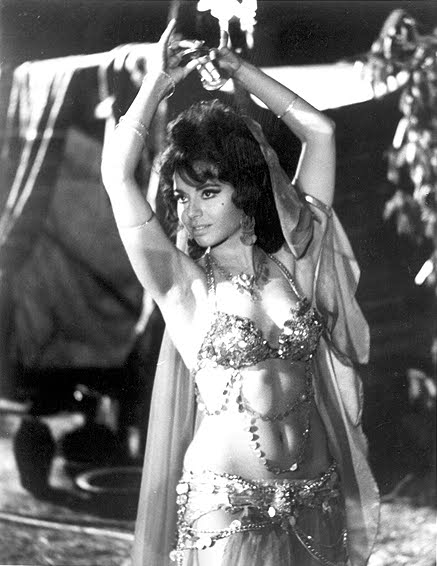From Russia With Love, 1963, was not the only movie featuring a bellydancer but the first that featured a real bellydancer in action displaying the credits on her tummy. Bellydancers started to populate the white screen even since the beginning of american cinema and later appeared also in european movies. Some actesses such as Gina Lollobrigida were really fine dancers and succeeded in bringing their own version of oriental dance, quite authentic.

Further east the Egyptian filmindusty had already a long tradition in entertaining the public with oriental dance.
In 1908 the College of Fine Arts was founded in Cairo, a development made possible by the fatwa issued by the Mufti of Egypt in 1905 decreeing that statues were prohibited only if intended for worship. Movies opened the eyes and minds of millions of egyptians to the world. In addition to the appearance of Mahmoud Mukhtar, Egypt's first sculptor since the age of the Pharaohs, Egyptian cultural life also teemed with the music of Sayed Darwish, Farid El Atrache, Mohamed Abdel-Wahab (1897-1991) and Umm Kulthoum (1898 -1975). Egyptian writers and novelists such as Taha Hussein, Ahmed Amin, Tawfiq El-Hakim and Naguib Mahfouz gained a brighter public as soon as their stories were filmed. Naguib Mahfouz won a Nobel Prize for literature in 1988. Youssef Chahine, Ahmed Badrakhan and Salah Abu Seif won international recognition for their work as film directors.
From 1946 up to 1956 Egyptian films competed in international filmfestivals.
Actresses such as Faten Hamama, Samia Gamal and Hind Rostom, Kouka and Tahia Karioka won the hearts of thousands admirers.  A fine example of this is Ehna Al-Talamza (We Are the Students,1959), co-written by Naguib Mahfouz and Mohamed Abu Youssef. This egyptian movie was casted stars like Tahiya Karioka, Shukri Sarhan, Omar Sharif and Youssef Fakhreddin. In this film dancer-actress Tahia Karioka showed her exellent dramatic skills. Egyptian cinema became popular not only because it was an extension of folk culture,i.e. the battle between good and evil, the victory of the poor over the rich, love over money and in particular because of the special blend of humour, passion, song and dance. Its popularity was also made possible because it was a liberal-spirited cinema, unhampered by sectarian and ethnic prejudices, championing the rights of women, children and the poor, engaging the combined efforts and outlooks of Muslims, Christians, Jews and Egyptians, Germans, Italians, Greeks, French, Hungarians, Iranians and Russians.
A fine example of this is Ehna Al-Talamza (We Are the Students,1959), co-written by Naguib Mahfouz and Mohamed Abu Youssef. This egyptian movie was casted stars like Tahiya Karioka, Shukri Sarhan, Omar Sharif and Youssef Fakhreddin. In this film dancer-actress Tahia Karioka showed her exellent dramatic skills. Egyptian cinema became popular not only because it was an extension of folk culture,i.e. the battle between good and evil, the victory of the poor over the rich, love over money and in particular because of the special blend of humour, passion, song and dance. Its popularity was also made possible because it was a liberal-spirited cinema, unhampered by sectarian and ethnic prejudices, championing the rights of women, children and the poor, engaging the combined efforts and outlooks of Muslims, Christians, Jews and Egyptians, Germans, Italians, Greeks, French, Hungarians, Iranians and Russians.
At the end of the 20th century Arab cinema once again lost his gained position. Women acting and singing became a taboo although on the other hand television stars like Youssra picked up the trade.
